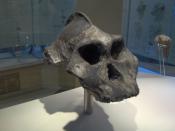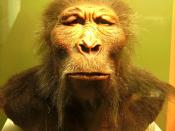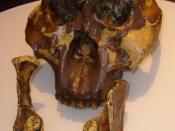Scientists have had much difficulty interpreting the phylogenetic relationships of the Black Skull because it is comprised of both primitive features and derived ones. It has a very small brain volume, a large sagittal crest, and the upper face projects considerably. All of these traits place it in the early Australopithecus afarensis grouping. However, the Black Skull also features derived traits associated with later robust hominids. This includes such traits as a broad face, a large palate, and a large area for the back teeth. Thus, a clear understanding of where this skull belongs becomes troublesome and a new species, Paranthropus aethiopicus, has been created for the skull.
Australopithecines can be defined as hominids from the Plio-Pleistocene era in Africa characterized by bipedal locomotion and a relatively small brain. Paranthropucines are similar to Australopithecines except they are defined as more robust, that is they have much larger teeth and larger jaws meant to process tough foods.
The Mystery Specimen from Station 5 resembles both Australopithecus afarensis and Paranthropus boisei, but because it has a sagittal crest, it must be a Paranthropus. It's primitive features are slight prognathism and a relatively small neurocranium. Its derived features include large molars, a wide flat face, and a sagittal crest.


